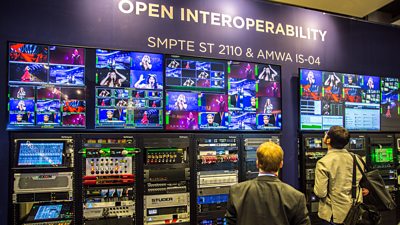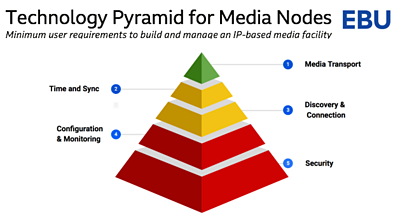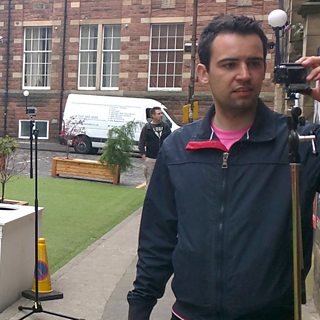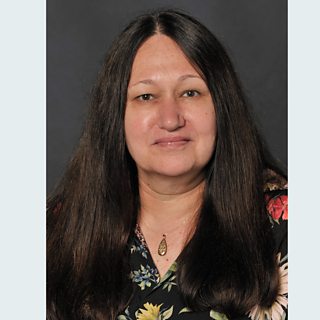The broadcast industry is now pushing to use live IP in production systems. The 成人快手 and other broadcasters need equipment, software and facilities that are future-proof and good value for money. We're working with manufacturers on flexible and open technical specifications that allow us to really benefit from the potential offered by IP networks.
Project from 2018 - present

Why are we doing this?
For many years, broadcast production facilities have been built from "specialist" technologies, such as the Serial Digital Interface (SDI). These have served us well, but as IP becomes an essential part of the future of the 成人快手 and the UK's creative economy, retaining these specialist technologies make it more difficult to modernise how content is produced. R&D has been been working on this problem for several years; at first this involved creating prototypes in our labs, and explaining our ideas to the industry. In 2014 we carried out a live multi-site all-IP UHD production trial at the Glasgow Commonweath Games. And more recently we've been developing solutions for object-based media and cloud-fit production, both of which are enabled through IP.
But broadcasters (and their production partners) still need equipment to make their content, and the IP Production Facilities workstream is all about what 成人快手 will need for its next generation of production systems. The idea is to make sure that this can happen in a way that can be connected up to the other parts of R&D's vision of a new broadcast system.
What are we doing?
Developing specifications
成人快手 is a principal member of the (AMWA), a trade body that provides business-driven solutions for networked media workflows. We lead the Networked Media Incubator project that is developing the (NMOS), which address how to control and manage networked media devices using web-based technologies. NMOS includes AMWA IS-04 and IS-05 which provide APIs for discovery and connection.
Standardisation
We contribute to a number of industry bodies, most notably the , who have traditionally been where the industry goes to for formal standards. The most high profile one (actually a suite of standards) is Professional Media Over Managed IP Networks, which specifies how to send video, audio and data as individual RTP streams. It has been adopted by many manufacturers and makes some of the work we did in the IP Studio project possible within the facility.
A lot more is currently happening in this area of standards and specification; see this blog post for more information.
Tests and trials
We are heavily involved in industry workshops and "plug-fests". In particular we organise AMWA Networked Media Incubator events where typically ten-to-fifteen companies come together to work on and test the NMOS specifications. The next one is in January (more info on the blog post).
We also provide expertise and presentations for industry showcases demonstrating the current state of IP. Most recently at IBC 2018, we presented a using IS-04 and IS-05.
We are also working with industry colleagues on how best to test IP-based equipment. For example we are helping to support development the EBU

Support for 成人快手 projects
成人快手 Wales's new facility in central Cardiff is building its core using IP and ST 2110. Network switches around the building replace the traditional SDI matrix, and "node" devices interface with cameras, monitors, etc. This is one of the first such projects in the world to try this on such a scale, and the Cardiff team is learning about what today's systems are capable of (or not). This is very technical work and we work closly with the team to provide advice, test tools and practical help, and in return receive valuable feedback on our specifications and requirements, such as how NMOS can be deployed across different types of network.
Implementation
And of course we write code to help us with all of the above. Some of it is open source, such as NMOS and . These play a big part in the workshops and help companies start developing what we need. By having our own implementations we are aware of how well they perform and any changes that are needed. And they provide building blocks for our other projects.
New requirements, new work
The Cardiff project shows what can be done using the standards-based solutions available on the market today. Uncompressed media transport, synchronisation, discovery and connection have been addressed, but there is clearly more to do for interoperability in configuration, monitoring and -- of course! -- security. The EBU's presents this as a challenge to the industry in a rather startling way (because the red parts are not yet available):

We're working with architects in 成人快手 Design + Engineering, and our EBU colleagues on further defining what is needed in these new areas, and working with AMWA on possible solutions. In particular we're working on how to use NMOS in secure environments.
One of the reasons for using IP is to enable productions to provision resources on demand using virtualisation and cloud technologies, as discussed for our Cloud-Fit Production project. ST 2110 isn't naturally suited to deployment in a cloud, so we expect "hybrid" architectures to evolve, and will be looking at how to ensure interoperability in these. This is likely to include work on ensuring that media identity and timing information is preserved, including where we need to go through compressed channels, such as for contribution from remote studios.
- -
- 成人快手 R&D - IP at the Core - Setting the Standards for Live IP Production
- 成人快手 R&D - High Speed Networking: Open Sourcing our Kernel Bypass Work
- 成人快手 R&D - Beyond Streams and Files - Storing Frames in the Cloud
- 成人快手 R&D - IP Studio
- 成人快手 R&D - IP Studio: Lightweight Live
- 成人快手 R&D - IP Studio: 2017 in Review - 2016 in Review
- 成人快手 R&D - IP Studio Update: Partners and Video Production in the Cloud
- 成人快手 R&D - Running an IP Studio
- 成人快手 R&D - Industry Workshop on Professional Networked Media
- 成人快手 R&D - The IP Studio
Project Team
Search by Tag:
- Tagged with IP Production and Broadcast IP Production and Broadcast
- Tagged with Production Production
- Tagged with Networks Networks
- Tagged with Video Video
- Tagged with Audio Audio
- Tagged with Metadata Metadata
- Tagged with Live Events Live Events
- Tagged with Devices Devices
- Tagged with Internet Internet
- Tagged with Synchronisation Synchronisation
- Tagged with Television Television
- Tagged with Radio Radio
- Tagged with Projects Projects






